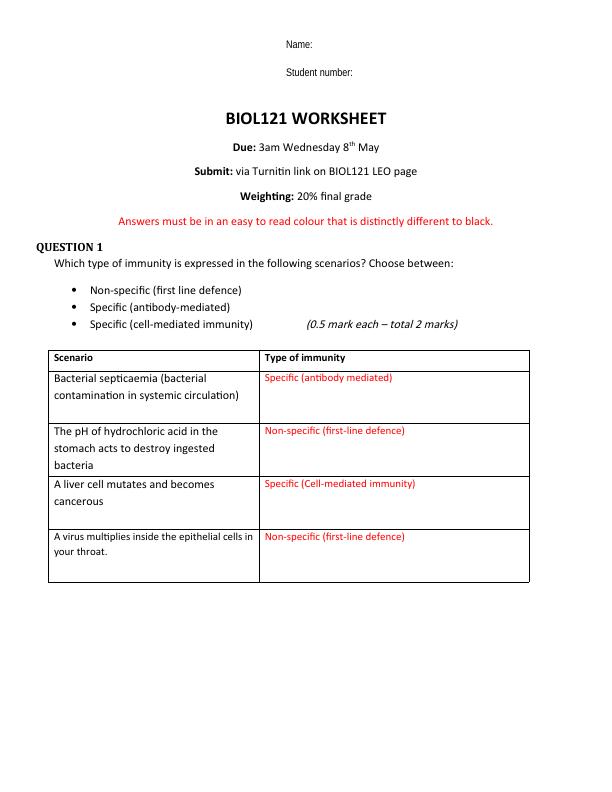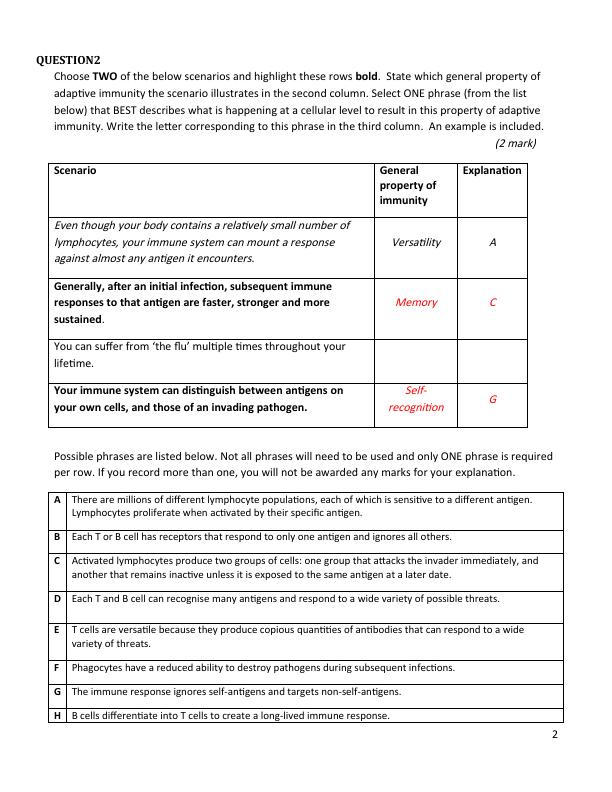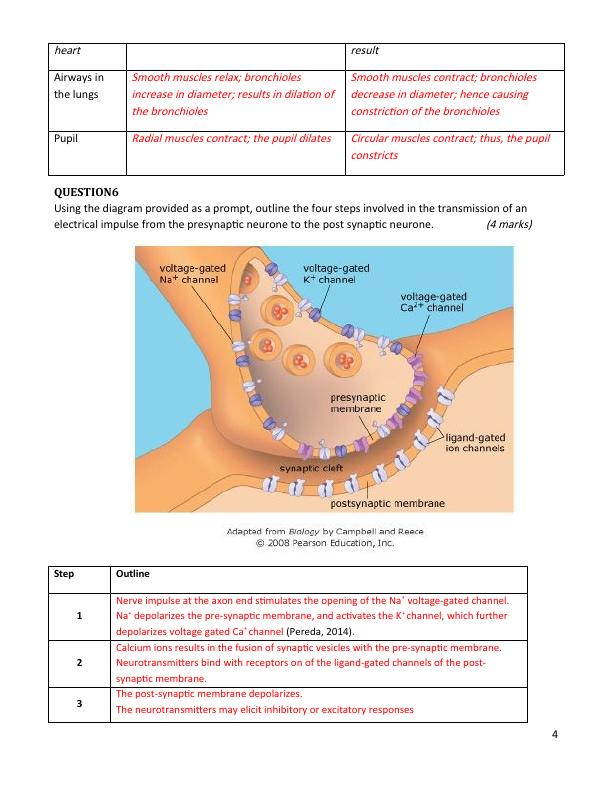Role of Bone Cells in Homeostasis of Blood Calcium Ion Concentration
Added on 2023-01-18
14 Pages3290 Words57 Views
Name:
Student number:
BIOL121 WORKSHEET
Due: 3am Wednesday 8th May
Submit: via Turnitin link on BIOL121 LEO page
Weighting: 20% final grade
Answers must be in an easy to read colour that is distinctly different to black.
QUESTION 1
Which type of immunity is expressed in the following scenarios? Choose between:
Non-specific (first line defence)
Specific (antibody-mediated)
Specific (cell-mediated immunity)
(0.5 mark each – total 2 marks)
Scenario Type of immunity
Bacterial septicaemia (bacterial
contamination in systemic circulation)
Specific (antibody mediated)
The pH of hydrochloric acid in the
stomach acts to destroy ingested
bacteria
Non-specific (first-line defence)
A liver cell mutates and becomes
cancerous
Specific (Cell-mediated immunity)
A virus multiplies inside the epithelial cells in
your throat.
Non-specific (first-line defence)
Student number:
BIOL121 WORKSHEET
Due: 3am Wednesday 8th May
Submit: via Turnitin link on BIOL121 LEO page
Weighting: 20% final grade
Answers must be in an easy to read colour that is distinctly different to black.
QUESTION 1
Which type of immunity is expressed in the following scenarios? Choose between:
Non-specific (first line defence)
Specific (antibody-mediated)
Specific (cell-mediated immunity)
(0.5 mark each – total 2 marks)
Scenario Type of immunity
Bacterial septicaemia (bacterial
contamination in systemic circulation)
Specific (antibody mediated)
The pH of hydrochloric acid in the
stomach acts to destroy ingested
bacteria
Non-specific (first-line defence)
A liver cell mutates and becomes
cancerous
Specific (Cell-mediated immunity)
A virus multiplies inside the epithelial cells in
your throat.
Non-specific (first-line defence)

QUESTION2
Choose TWO of the below scenarios and highlight these rows bold. State which general property of
adaptive immunity the scenario illustrates in the second column. Select ONE phrase (from the list
below) that BEST describes what is happening at a cellular level to result in this property of adaptive
immunity. Write the letter corresponding to this phrase in the third column. An example is included.
(2 mark)
Scenario General
property of
immunity
Explanation
Even though your body contains a relatively small number of
lymphocytes, your immune system can mount a response
against almost any antigen it encounters.
Versatility
A
Generally, after an initial infection, subsequent immune
responses to that antigen are faster, stronger and more
sustained.
Memory
C
You can suffer from ‘the flu’ multiple times throughout your
lifetime.
Your immune system can distinguish between antigens on
your own cells, and those of an invading pathogen.
Self-
recognition
G
Possible phrases are listed below. Not all phrases will need to be used and only ONE phrase is required
per row. If you record more than one, you will not be awarded any marks for your explanation.
A There are millions of different lymphocyte populations, each of which is sensitive to a different antigen.
Lymphocytes proliferate when activated by their specific antigen.
B Each T or B cell has receptors that respond to only one antigen and ignores all others.
C Activated lymphocytes produce two groups of cells: one group that attacks the invader immediately, and
another that remains inactive unless it is exposed to the same antigen at a later date.
D Each T and B cell can recognise many antigens and respond to a wide variety of possible threats.
E T cells are versatile because they produce copious quantities of antibodies that can respond to a wide
variety of threats.
F Phagocytes have a reduced ability to destroy pathogens during subsequent infections.
G The immune response ignores self-antigens and targets non-self-antigens.
H B cells differentiate into T cells to create a long-lived immune response.
2
Choose TWO of the below scenarios and highlight these rows bold. State which general property of
adaptive immunity the scenario illustrates in the second column. Select ONE phrase (from the list
below) that BEST describes what is happening at a cellular level to result in this property of adaptive
immunity. Write the letter corresponding to this phrase in the third column. An example is included.
(2 mark)
Scenario General
property of
immunity
Explanation
Even though your body contains a relatively small number of
lymphocytes, your immune system can mount a response
against almost any antigen it encounters.
Versatility
A
Generally, after an initial infection, subsequent immune
responses to that antigen are faster, stronger and more
sustained.
Memory
C
You can suffer from ‘the flu’ multiple times throughout your
lifetime.
Your immune system can distinguish between antigens on
your own cells, and those of an invading pathogen.
Self-
recognition
G
Possible phrases are listed below. Not all phrases will need to be used and only ONE phrase is required
per row. If you record more than one, you will not be awarded any marks for your explanation.
A There are millions of different lymphocyte populations, each of which is sensitive to a different antigen.
Lymphocytes proliferate when activated by their specific antigen.
B Each T or B cell has receptors that respond to only one antigen and ignores all others.
C Activated lymphocytes produce two groups of cells: one group that attacks the invader immediately, and
another that remains inactive unless it is exposed to the same antigen at a later date.
D Each T and B cell can recognise many antigens and respond to a wide variety of possible threats.
E T cells are versatile because they produce copious quantities of antibodies that can respond to a wide
variety of threats.
F Phagocytes have a reduced ability to destroy pathogens during subsequent infections.
G The immune response ignores self-antigens and targets non-self-antigens.
H B cells differentiate into T cells to create a long-lived immune response.
2

QUESTION 3
Describe how bone cells respond to the hormones involved in the homeostasis of blood calcium ion
concentration.
(3 marks)
Bone cells are crucial in homeostasis of blood calcium. Parathyroid glands release parathyroid hormone
(PTH) when there are low blood calcium levels, which stimulates bone resorption. Besides, PTH directly
affects the kidneys by preventing the loss of calcium ions through urine; hence reabsorption of the
ions. On the other hand, thyroid glands release calcitonin in response to high blood calcium. Calcitonin
suppresses bone resorption activity and increases the amount of calcium excreted in urine. PTH and
calcitonin act as feedback mechanisms to balance blood calcium ion concentrations (Chonchol &
Kendrick, 2019).
QUESTION 4
Why is injury to the medulla oblongata usually fatal?
(2 marks)
Medulla oblongata is found on brain stem. It is essential in regulating the body’s involuntary processes,
such as respiration, digestion, reflex, and neuronal responses. An injury to this part is life-threatening
as it may disrupt the involuntary processes. It may cause paralysis, loss of body coordination, loss
touch senses, and ultimately cause death.
QUESTION 5
Complete the following table summarising the effects of autonomic innervation on target tissues. You
must include both the effect upon the target tissue and a consequence of this stimulation in your
answer.
The first row has been completed as an example. (1 mark/box; 4 marks total)
Target tissue Effect of sympathetic stimulation Effect of parasympathetic stimulation
Contractile
force of the
Contractile force increases; more blood
pumped from heart
No parasympathetic innervation of
ventricular myocardium; therefore, no
3
Describe how bone cells respond to the hormones involved in the homeostasis of blood calcium ion
concentration.
(3 marks)
Bone cells are crucial in homeostasis of blood calcium. Parathyroid glands release parathyroid hormone
(PTH) when there are low blood calcium levels, which stimulates bone resorption. Besides, PTH directly
affects the kidneys by preventing the loss of calcium ions through urine; hence reabsorption of the
ions. On the other hand, thyroid glands release calcitonin in response to high blood calcium. Calcitonin
suppresses bone resorption activity and increases the amount of calcium excreted in urine. PTH and
calcitonin act as feedback mechanisms to balance blood calcium ion concentrations (Chonchol &
Kendrick, 2019).
QUESTION 4
Why is injury to the medulla oblongata usually fatal?
(2 marks)
Medulla oblongata is found on brain stem. It is essential in regulating the body’s involuntary processes,
such as respiration, digestion, reflex, and neuronal responses. An injury to this part is life-threatening
as it may disrupt the involuntary processes. It may cause paralysis, loss of body coordination, loss
touch senses, and ultimately cause death.
QUESTION 5
Complete the following table summarising the effects of autonomic innervation on target tissues. You
must include both the effect upon the target tissue and a consequence of this stimulation in your
answer.
The first row has been completed as an example. (1 mark/box; 4 marks total)
Target tissue Effect of sympathetic stimulation Effect of parasympathetic stimulation
Contractile
force of the
Contractile force increases; more blood
pumped from heart
No parasympathetic innervation of
ventricular myocardium; therefore, no
3

heart
result
Airways in
the lungs
Smooth muscles relax; bronchioles
increase in diameter; results in dilation of
the bronchioles
Smooth muscles contract; bronchioles
decrease in diameter; hence causing
constriction of the bronchioles
Pupil
Radial muscles contract; the pupil dilates Circular muscles contract; thus, the pupil
constricts
QUESTION6
Using the diagram provided as a prompt, outline the four steps involved in the transmission of an
electrical impulse from the presynaptic neurone to the post synaptic neurone.
(4 marks)
Step Outline
1
Nerve impulse at the axon end stimulates the opening of the Na+ voltage-gated channel.
Na+ depolarizes the pre-synaptic membrane, and activates the K+ channel, which further
depolarizes voltage gated Ca+ channel (Pereda, 2014).
2
Calcium ions results in the fusion of synaptic vesicles with the pre-synaptic membrane.
Neurotransmitters bind with receptors on of the ligand-gated channels of the post-
synaptic membrane.
3 The post-synaptic membrane depolarizes.
The neurotransmitters may elicit inhibitory or excitatory responses
4
result
Airways in
the lungs
Smooth muscles relax; bronchioles
increase in diameter; results in dilation of
the bronchioles
Smooth muscles contract; bronchioles
decrease in diameter; hence causing
constriction of the bronchioles
Pupil
Radial muscles contract; the pupil dilates Circular muscles contract; thus, the pupil
constricts
QUESTION6
Using the diagram provided as a prompt, outline the four steps involved in the transmission of an
electrical impulse from the presynaptic neurone to the post synaptic neurone.
(4 marks)
Step Outline
1
Nerve impulse at the axon end stimulates the opening of the Na+ voltage-gated channel.
Na+ depolarizes the pre-synaptic membrane, and activates the K+ channel, which further
depolarizes voltage gated Ca+ channel (Pereda, 2014).
2
Calcium ions results in the fusion of synaptic vesicles with the pre-synaptic membrane.
Neurotransmitters bind with receptors on of the ligand-gated channels of the post-
synaptic membrane.
3 The post-synaptic membrane depolarizes.
The neurotransmitters may elicit inhibitory or excitatory responses
4

End of preview
Want to access all the pages? Upload your documents or become a member.
Related Documents
Questions and Answers - BIOL121lg...
|17
|3542
|279
Role of Baroreceptors in Blood Pressure Controllg...
|17
|4024
|467
BIOL121 Worksheet: Immunity, Bone Cells, Muscle Contraction, Urine Formationlg...
|17
|3838
|84
Role of Baroreceptors in Blood Pressure Controllg...
|16
|3461
|44
BIOL121 Worksheetlg...
|13
|3457
|345
Solution Paper Questions 2022lg...
|21
|3688
|28
